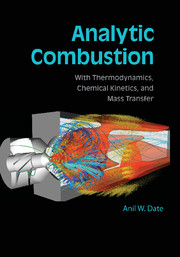Book contents
- Frontmatter
- Contents
- Preface
- Symbols and Acronyms
- 1 Introduction
- 2 Thermodynamics of a Pure Substance
- 3 Thermodynamics of Gaseous Mixtures
- 4 Chemical Equilibrium
- 5 Chemical Kinetics
- 6 Derivation of Transport Equations
- 7 Thermochemical Reactors
- 8 Premixed Flames
- 9 Diffusion Flames
- 10 Combustion of Particles and Droplets
- 11 Combustion Applications
- APPENDIX A Thermochemistry Data
- APPENDIX B Curve-Fit Coefficients for Δhc, Tad, Kp, Cp, h, and s
- APPENDIX C Properties of Fuels
- APPENDIX D Thermophysical and Transport Properties of Gases
- APPENDIX E Atmospheric Data
- APPENDIX F Binary Diffusion Coefficients at 1 atm and T = 300K
- Bibliography
- Index
7 - Thermochemical Reactors
- Frontmatter
- Contents
- Preface
- Symbols and Acronyms
- 1 Introduction
- 2 Thermodynamics of a Pure Substance
- 3 Thermodynamics of Gaseous Mixtures
- 4 Chemical Equilibrium
- 5 Chemical Kinetics
- 6 Derivation of Transport Equations
- 7 Thermochemical Reactors
- 8 Premixed Flames
- 9 Diffusion Flames
- 10 Combustion of Particles and Droplets
- 11 Combustion Applications
- APPENDIX A Thermochemistry Data
- APPENDIX B Curve-Fit Coefficients for Δhc, Tad, Kp, Cp, h, and s
- APPENDIX C Properties of Fuels
- APPENDIX D Thermophysical and Transport Properties of Gases
- APPENDIX E Atmospheric Data
- APPENDIX F Binary Diffusion Coefficients at 1 atm and T = 300K
- Bibliography
- Index
Summary
Introduction
Our interest now is to achieve design or performance predictions of combustion devices. The word design refers to the determination of the geometry (length, diameter, shape) of the device and to ensuring safety for a desired product composition. Performance prediction implies the reverse – that is, determining product composition for a given geometry and safe operating conditions.
Combustion devices can be long and slender, as in a gas-turbine combustion chamber, a cement kiln, or a pulverized fuel (mainly coal)-fired boiler, in which air + fuel enter at one end and products leave at the other. Such devices can be idealized as plug-flow thermochemical reactors (PFTCRs). In a PFTCR operating under steady state, properties such as velocity, temperature, pressure, and mass fractions of species vary principally along the length of the reactor. Therefore, for such reactors, equations of mass, momentum, and energy may be simplified to their one-dimensional forms.
Devices known as furnaces (used in ceramic or steel making) are similar but rather stubby, with their spatial dimensions in the three directions being nearly equal. Such devices are formally called well-stirred thermochemical reactors (WSTCRs). Thus, the combustion space in a wood-burning cookstove may also be called a WSCTR. AWSTCR is a stubby PFTCR. Therefore, the governing equations can be reduced to a set of zero-dimensional algebraic equations.
- Type
- Chapter
- Information
- Analytic CombustionWith Thermodynamics, Chemical Kinetics and Mass Transfer, pp. 134 - 163Publisher: Cambridge University PressPrint publication year: 2011

